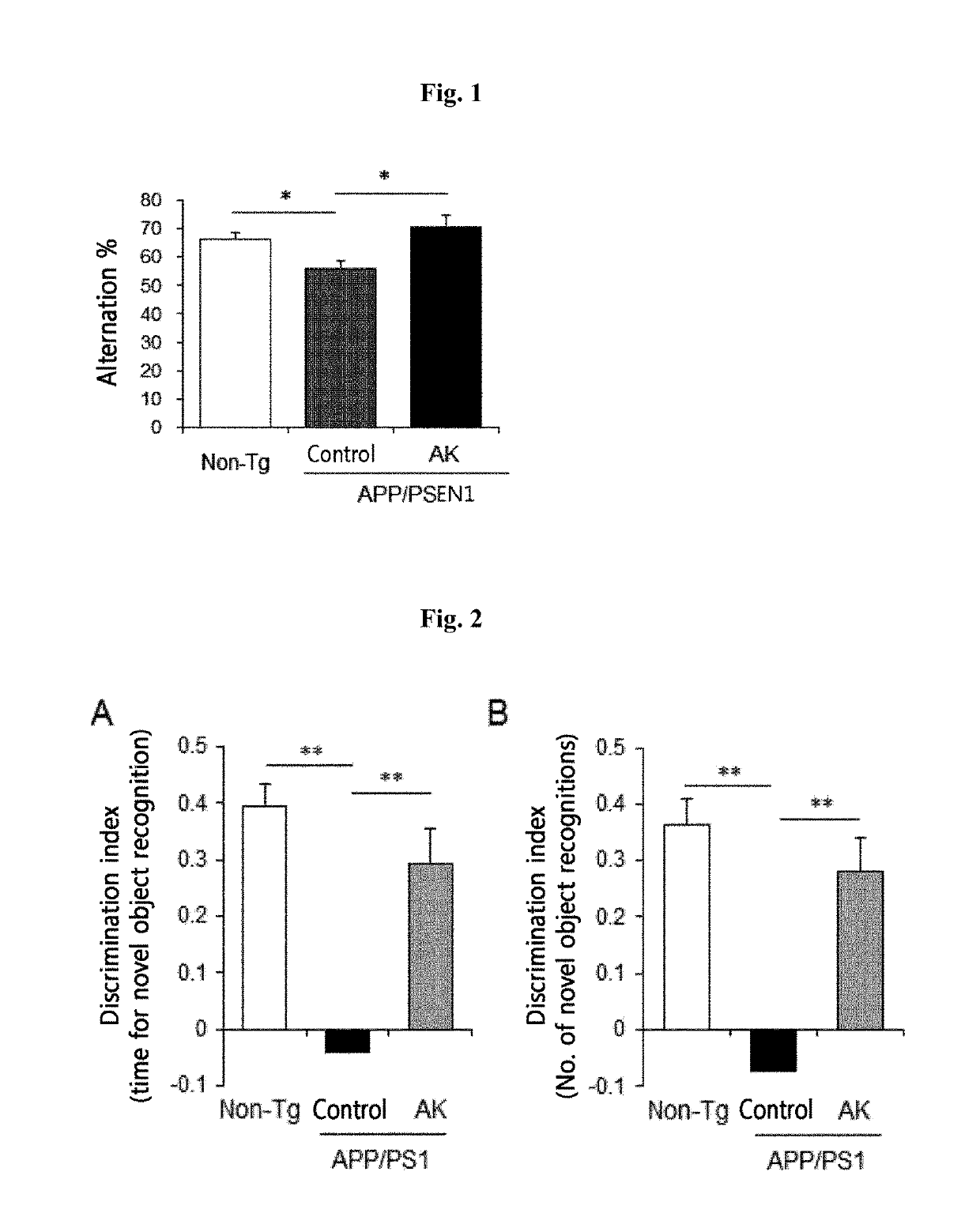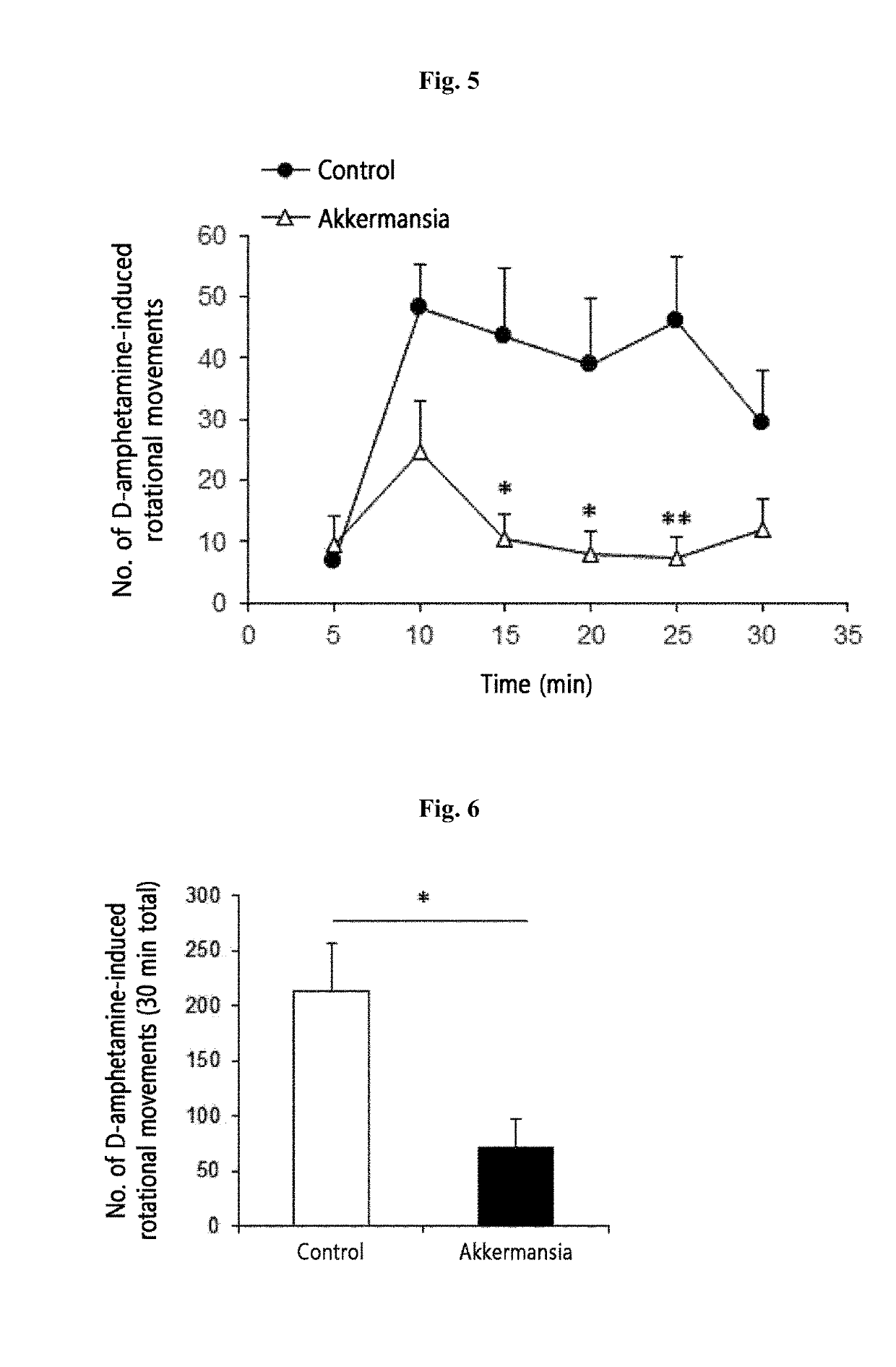Akkermansia muciniphila strain having a prophylactic or therapeutic effect on a degenerative brain disease or metabolic disease and use thereof
a technology of metabolic disease and akkermansia muciniphila, which is applied in the field of akkermansia muciniphila strain having a prophylactic or therapeutic effect on a degenerative brain disease or metabolic disease, can solve the problems of not being able to treat the fundamental onset of alzheimer's disease, and not being able to achieve the fundamental therapeutic effect. , to achieve the effect of improving
- Summary
- Abstract
- Description
- Claims
- Application Information
AI Technical Summary
Benefits of technology
Problems solved by technology
Method used
Image
Examples
example 1
t on In Vivo Efficacy of Akkermansia muciniphila (AK) on Alzheimer's Disease, Dementia and Cognitive Function of Brain
[0092]1-1. Experiment Using a Mouse Model Having Overexpressed Alzheimer's Disease Genes
[0093]Mice models having Alzheimer's disease induced by the overexpression of APP and PSEN1 genes (Alzheimer's disease-related genes) was purchased from The Jackson Laboratory (B6C3-Tg(APPswe / PSEN1dE9)85DboJ, JAX, 004462). The experimental animal group was divided into a group of 5-month old normal mice (Non-Tg) having no overexpressed APP / PSEN1 (n=6) and a group of mice having Alzheimer's disease overexpressing APP / PSEN1 (n=15). The group of mice having Alzheimer's disease was further divided into a control group administered with 25% glycerol / PBS and an experimental group orally administered 2.0×108 CFU of the Akkermansia muciniphila strain every day. The numbers of the mice in the control and experimental groups of Alzheimer's disease overexpressing the APP / PSEN1 were 9 and 6, ...
example 2
fficacy of Akkermansia muciniphila (AK) on Parkinson's Diseases
[0106]2-1. Animal Model and Administration of Akkermansia muciniphila Strain
[0107]8-week-old male C57BL / 6 mice were used: the control group was administered with 25% glycerol / PBS and the experimental group was daily orally administered with 2.0×108 CFU of the Akkermansia muciniphila strain for 1 week. 6-Hydroxydopamine (6-OHDA) was further added directly to the left corpus striatum to induce dopaminergic cell loss so as to manufacture an animal model having Parkinson's disease. The effect of administration of the Akkermansia muciniphila strain was analyzed.
[0108]2-2. Analysis of Movement Control Dysfunction Induced by Parkinson's Disease
[0109]To ethologically analyze movement control dysfunction caused by Parkinson's disease according to the administration of the Akkermansia muciniphila strain, mice were subjected to D-amphetamine-induced rotation test to measure asymmetrical dyskinesia.
[0110]2-3. Observation Result
[0111...
example 3
of Hyperlipidemia-Improving Effect of Akkermansia muciniphila (AK) Strain when Orally Administered to an Animal Model Having Hyperlipidemia Induced by High-Fat Diet
[0112]8-week-old male C57BL / 6 mice, fed with high-fat feed for 6 weeks to induce alimentary obesity, were grouped in fives and kept feeding with high-fat feed, while the control group was administered with vehicle (25% glycerol / PBS) and the experimental groups were administered with 2.0×108 CFU AK(+) proliferated in a mucin-containing medium and 1.0×107 CFU AK(−) proliferated in a mucin-free medium, respectively, once daily for 5 weeks. After 5 weeks, the mice were fasted for 16 hours, followed by collecting blood thereof to measure the concentrations of fasting serum cholesterol and triglyceride to compare and analyze.
[0113]Plasma was separated from the blood collected from each animal after 16 hours of fasting, and blood cholesterol and triglyceride concentrations were measured to compare and analyze using a hematology ...
PUM
 Login to View More
Login to View More Abstract
Description
Claims
Application Information
 Login to View More
Login to View More - R&D
- Intellectual Property
- Life Sciences
- Materials
- Tech Scout
- Unparalleled Data Quality
- Higher Quality Content
- 60% Fewer Hallucinations
Browse by: Latest US Patents, China's latest patents, Technical Efficacy Thesaurus, Application Domain, Technology Topic, Popular Technical Reports.
© 2025 PatSnap. All rights reserved.Legal|Privacy policy|Modern Slavery Act Transparency Statement|Sitemap|About US| Contact US: help@patsnap.com



